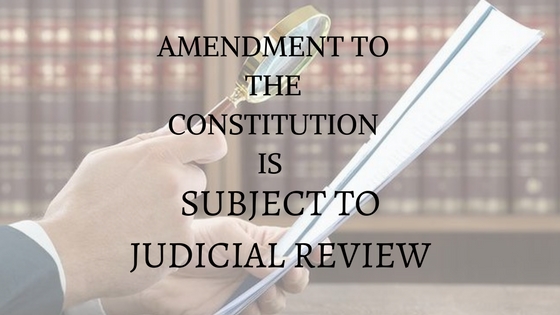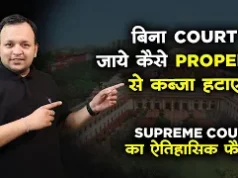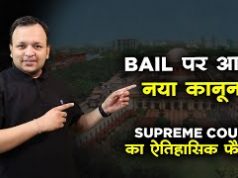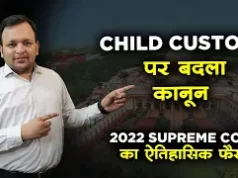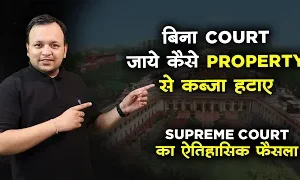Aapka Consultant Judgment Series- In this series, we are providing case analysis of Landmark Judgments of Hon’ble Supreme Court of India.
I.R. Coelho (Dead) By LRs. vs. State of Tamil Nadu and Ors.
AIR 2007 SC 861; (2007) 2 SCC 1, [2007]1SCR706
Hon’ble Judges/Coram: Y.K. Sabharwal, C.J., Ashok Bhan, Dr. Arijit Pasayat, B.P. Singh, S.H. Kapadia, C.K. Thakker, P.K. Balasubramanyan, Altamas Kabir and D.K. Jain, JJ.
Decided On: 11.01.2007
FACTS:-
In these matters Court was confronted with a very important yet not very easy task of determining the nature and character of protection provided by Article 31-B of the Constitution of India, 1950 (for short, the ‘Constitution’) to the laws added to the Ninth Schedule by amendments made after 24th April, 1973.
Our auto accident lawyer in Aurora, Illinois understand this and will be more than happy to answer all your questions and guide you through the entire process.
The relevance of this date is for the reason that on this date judgment in his holiness Kesavananda Bharati, Sripadagalvaru v. State of Kerala and Anr. AIR1973SC1461 was pronounced propounding the doctrine of Basic Structure of the Constitution to test the validity of constitutional amendments.
ISSUE:-
The fundamental question is whether on and after 24th April, 1973 when basic structures doctrine was propounded, it is permissible for the Parliament under Article 31B to immunize legislations from fundamental rights by inserting them into the Ninth Schedule and, if so, what is its effect on the power of judicial review of the Court.
JUDGMENT:-
The Constitution is a living document. The constitutional provisions have to be construed having regard to the march of time and the development of law. It is, therefore, necessary that while construing the doctrine of basic structure due regard be had to various decisions which led to expansion and development of the law. The principle of constitutionalism is now a legal principle which requires control over the exercise of Governmental power to ensure that it does not destroy the democratic principles upon which it is based. These democratic principles include the protection of fundamental rights. The principle of constitutionalism advocates a check and balance model of the separation of powers, it requires a diffusion of powers, necessitating different independent centers of decision making. The principle of constitutionalism underpins the principle of legality which requires the Courts to interpret legislation on the assumption that Parliament would not wish to legislate contrary to fundamental rights. The Legislature can restrict fundamental rights but it is impossible for laws protecting fundamental rights to be impliedly repealed by future statutes.
For determining whether a particular feature of the Constitution is part of its basic structure, one has per force to examine in each individual case the place of the particular feature in the scheme of our Constitution, its object and purpose, and the consequences of its denial on the integrity of the Constitution as a fundamental instrument of the country’s governance. The fundamentalness of fundamental rights has thus to be examined having regard to the enlightened point of view as a result of development of fundamental rights over the years. It is, therefore, imperative to understand the nature of guarantees under fundamental rights as understood in the years that immediately followed after the Constitution was enforced when fundamental rights were viewed by this Court as distinct and separate rights. In early years, the scope of the guarantee provided by these rights was considered to be very narrow. Individuals could only claim limited protection against the State. This position has changed since long. Over the years, the jurisprudence and development around fundamental rights has made it clear that they are not limited, narrow rights but provide a broad check against the violations or excesses by the State authorities. The fundamental rights have in fact proved to be the most significant constitutional control on the Government, particularly legislative power. This transition from a set of independent, narrow rights to broad checks on state power is demonstrated by a series of cases that have been decided by this Court. In the State of Bombay v. Bhanji Munji and Anr. [1955]1SCR777 relying on the ratio of A.K Gopalan v. The State of Madras 1950CriLJ1383 it was held that Article 31 was independent of Article 19(1)(f). However, it was in Rustom Cavasjee Cooper v. Union of India [1970]3SCR530 (popularly known as Bank Nationalization case) the view point of Gopalan Case (supra) was seriously disapproved. While rendering this decision, the focus of the Court was on the actual impairment caused by the law, rather than the literal validity of the law. This view was reflective of the decision taken in the case of Sakal Papers (P) Ltd. and Ors. v. The Union of India [1962]3SCR842 where the court was faced with the validity of certain legislative measures regarding the control of newspapers and whether it amounted to infringement of Article 19(1)(a). While examining this question the Court stated that the actual effect of the law on the right guaranteed must be taken into account. This ratio was applied in Bank Nationalization case. The Court examined the relation between Article 19(1)(f) and Article 13 and held that they were not mutually exclusive. The ratio of Gopalan was not approved. The abrogation or abridgment of the fundamental rights under Chapter III have, therefore, to be examined on broad interpretation, the narrow interpretation of fundamental rights chapter is a thing of past. Interpretation of the Constitution has to be such as to enable the citizens to enjoy the rights guaranteed by Part III in the fullest measure.
Fundamental rights enshrined in Part III were added to the Constitution as a check on the State power, particularly the legislative power. Through Article 13, it is provided that the State cannot make any laws that are contrary to Part III. The framers of the Constitution have built a wall around certain parts of fundamental rights, which have to remain forever, limiting ability of majority to intrude upon them. That wall is the ‘Basic Structure’ doctrine. Under Article 32, which is also part of Part III, Supreme Court has been vested with the power to ensure compliance of Part III. The responsibility to judge the constitutionality of all laws is that of judiciary. Thus, when power under Article 31-B is exercised, the legislations made completely immune from Part III results in a direct way out of the check of Part III including that of Article 32. It cannot be said that the same Constitution that provides for a check on legislative power, will decide whether such a check is necessary or not. It would be a negation of the Constitution. In Waman Rao & others v. Union of India & others [(1981) 2 SCC 362], while discussing the application of basic structure doctrine to the first amendment, it was observed that the measure of the permissibility of an amendment of a pleading is how far it is consistent with the original; you cannot by an amendment transform the original into opposite of what it is. For that purpose, a comparison is undertaken to match the amendment with the original. Such a comparison can yield fruitful results even in the rarefied sphere of constitutional law.
Indeed, if Article 31B only provided restricted immunity and it seems that original intent was only to protect a limited number of laws, it would have been only exception to Part III and the basis for the initial upholding of the provision. However, the unchecked and rampant exercise of this power shows that it is no longer a mere exception. The absence of guidelines for exercise of such power means the absence of constitutional control which results in destruction of constitutional supremacy and creation of parliamentary hegemony and absence of full power of judicial review to determine the constitutional validity of such exercise. Article 31A does not exclude uncatalogued number of laws from challenge on the basis of Part III. It provides for a standard by which laws stand excluded from Judicial Review. Likewise, Article 31C applies as a yardstick the criteria of Sub-clauses (b) and (c) of Article 39 which refers to equitable distribution of resources. The fundamental rights have always enjoyed a special and privileged place in the Constitution. Economic growth and social equity are the two pillars of our Constitution which are linked to the rights of an individual (right to equal opportunity), rather than in the abstract. Some of the rights in Part III constitute fundamentals of the Constitution like Article 21 read with Articles 14 and 15 which represent secularism etc. As held, egalitarian equality exists in Article 14 read with Article 16(4) (4A) (4B) and, therefore, it is wrong to suggest that equity and justice finds place only in the Directive Principles.
The Parliament has power to amend the provisions of Part III so as to abridge or take away fundamental rights, but that power is subject to the limitation of basic structure doctrine. Whether the impact of such amendment results in violation of basic structure has to be examined with reference to each individual case. The impact of such an amendment shall have to be tested on the touchstone of rights and freedoms guaranteed by Part III of the Constitution. Therefore, one has to take a synoptic view of the various Articles in Part III while judging the impact of the laws incorporated in the Ninth Schedule on the Articles in Part III. That apart after enunciation of the basic structure doctrine, full judicial review is an integral part of the constitutional scheme. Keeping in mind the above principles the Court is of the view that while laws may be added to the Ninth Schedule, once Article 32 is triggered, these legislations must answer to the complete test of fundamental rights. Every insertion into the Ninth Schedule does not restrict Part III review, it completely excludes Part III at will. For this reason, every addition to the Ninth Schedule triggers Article 32 as part of the basic structure and is consequently subject to the review of the fundamental rights as they stand in Part III.
Further it said that the constitutional amendments are subject to limitations and if the question of limitation is to be decided by the Parliament itself which enacts the impugned amendments and gives that law a complete immunity, it would disturb the checks and balances in the Constitution. The authority to enact law and decide the legality of the limitations cannot vest in one organ. The validity to the limitation on the rights in Part III can only be examined by another independent organ, namely, the judiciary. The power to grant absolute immunity at will is not compatible with basic structure doctrine and, therefore, after 24th April, 1973 the laws included in the Ninth Schedule would not have absolute immunity. Thus, validity of such laws can be challenged on the touchstone of basic structure such as reflected in Article 21 read with Article 14 and Article 19, Article 15 and the principles underlying these Articles.
The doctrine of basic structure as a principle has now become an axiom. It is premised on the basis that invasion of certain freedoms needs to be justified. It is the invasion which attracts the basic structure doctrine. The existence of the power of Parliament to amend the Constitution at will, with requisite voting strength, so as to make any kind of laws that excludes Part III including power of judicial review under Article 32 is incompatible with the basic structure doctrine, therefore, such an exercise if challenged, has to be tested on the touchstone of basic structure as reflected in Article 21 read with Article 14 and Article 19, Article 15 and the principles thereunder.
The power to amend the Constitution is subject to aforesaid axiom. It is, thus, no more plenary in the absolute sense of the term. Prior to Kesavananda Bharati case, the axiom was not there. Fictional validation based on the power of immunity exercised by the Parliament under Article 368 is not compatible with the basic structure doctrine and, therefore, the laws that are included in the Ninth Schedule have to be examined individually for determining whether the constitutional amendments by which they are put in the Ninth Schedule damage or destroy the basic structure of the Constitution. This Court being bound by all the provisions of the Constitution and also by the basic structure doctrine has necessarily to scrutinize the Ninth Schedule laws. It has to examine the terms of the statute, the nature of the rights involved, etc. to determine whether in effect and substance the statute violates the essential features of the Constitution. For so doing, it has to first find whether the Ninth Schedule law is violative of Part III. If on such examination, the answer is in the affirmative, the further examination to be undertaken is whether the violation found is destructive of the basic structure doctrine. If on such further examination the answer is again in affirmative, the result would be invalidation of the Ninth Schedule Law, therefore, first the violation of rights of Part III is required to be determined, then its impact examined and if it shows that in effect and substance, it destroys the basic structure of the Constitution, the consequence of invalidation has to follow. Every time such amendment is challenged, to hark back to Kesavananda Bharati upholding the validity of Article 31B is a surest means of a drastic erosion of the fundamental rights conferred by Part III.
Article 31B gives validation based on fictional immunity. In judging the validity of constitutional amendment we have to be guided by the impact test. The basic structure doctrine requires the State to justify the degree of invasion of fundamental rights. Parliament is presumed to legislate compatibly with the fundamental rights and this is where Judicial Review comes in. The greater the invasion into essential freedoms, greater is the need for justification and determination by court whether invasion was necessary and if so to what extent. The degree of invasion is for the Court to decide. Compatibility is one of the species of Judicial Review which is premised on compatibility with rights regarded as fundamental. The power to grant immunity, at will, on fictional basis, without full judicial review, will nullify the entire basic structure doctrine. The golden triangle referred to above is the basic feature of the Constitution as it stands for equality and rule of law.
The result of aforesaid discussion is that the constitutional validity of the Ninth Schedule Laws on the touchstone of basic structure doctrine can be adjudged by applying the direct impact and effect test, i.e., rights test, which means the form of an amendment is not the relevant factor, but the consequence thereof would be determinative factor.
HELD:-
Following principles were held by the Court:
- A law that abrogates or abridges rights guaranteed by Part III of the Constitution may violate the basic structure doctrine or it may not. If former is the consequence of law, whether by amendment of any Article of Part III or by an insertion in the Ninth Schedule, such law will have to be invalidated in exercise of judicial review power of the Court. The validity or invalidity would be tested on the principles laid down in this judgment.
- The majority judgment in Kesavananda Bharati’s case read with Indira Gandhi’s case, requires the validity of each new constitutional amendment to be judged on its own merits. The actual effect and impact of the law on the rights guaranteed under Part III has to be taken into account for determining whether or not it destroys basic structure. The impact test would determine the validity of the challenge.
- All amendments to the Constitution made on or after 24th April, 1973 by which the Ninth Schedule is amended by inclusion of various laws therein shall have to be tested on the touchstone of the basic or essential features of the Constitution as reflected in Article 21 read with Article 14, Article 19, and the principles underlying them. To put it differently even though an Act is put in the Ninth Schedule by a constitutional amendment, its provisions would be open to attack on the ground that they destroy or damage the basic structure if the fundamental right or rights taken away or abrogated pertains or pertain to the basic structure.
- Justification for conferring protection, not blanket protection, on the laws included in the Ninth Schedule by Constitutional Amendments shall be a matter of Constitutional adjudication by examining the nature and extent of infraction of a Fundamental Right by a statute, sought to be Constitutionally protected, and on the touchstone of the basic structure doctrine as reflected in Article 21 read with Article 14 and Article 19 by application of the “rights test” and the “essence of the right” test taking the synoptic view of the Articles in Part III as held in Indira Gandhi’s case. Applying the above tests to the Ninth Schedule laws, if the infraction affects the basic structure then such a law(s) will not get the protection of the Ninth Schedule.
- If the validity of any Ninth Schedule law has already been upheld by this Court, it would not be open to challenge such law again on the principles declared by this judgment. However, if a law held to be violative of any rights in Part III is subsequently incorporated in the Ninth Schedule after 24th April, 1973, such a violation/infraction shall be open to challenge on the ground that it destroys or damages the basic structure as indicated in Article 21 read with Article 14, Article 19 and the principles underlying thereunder.
- Action taken and transactions finalized as a result of the impugned Acts shall not be open to challenge.To Get Legal Opinion from Advocates/ Legal Experts, Please click here
To Get Legal Opinion from Retired Hon’ble Judges, Please click here



